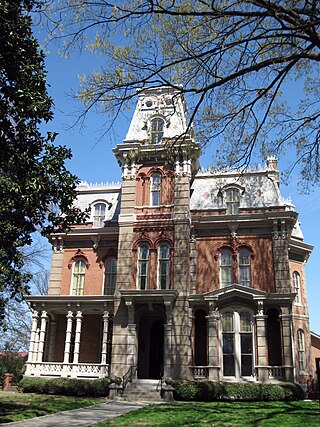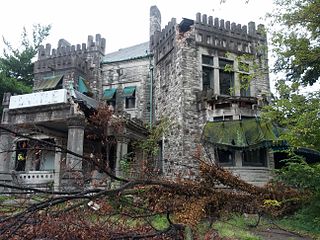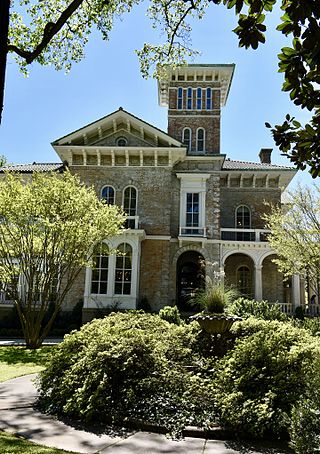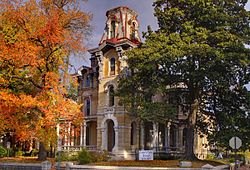
Downtown Memphis, Tennessee is the central business district of Memphis, Tennessee and is located along the Mississippi River between Interstate 40 to the north, Interstate 55 to the south and I-240 to the east, where it abuts Midtown Memphis.

The Peabody Memphis is a historic luxury hotel in Downtown Memphis, Tennessee, opened in 1925. The hotel is known for the "Peabody Ducks" that live on the hotel rooftop and make daily treks to the lobby. The Peabody is a member of Historic Hotels of America, a program of the National Trust for Historic Preservation.

Maxwelton is a historic single-story house in Memphis, Tennessee, that is listed on the National Register of Historic Places. It is the only extant example in Memphis of a Victorian piano box house. It is currently a private residence.

The Museum of Science & History - Pink Palace in Memphis, Tennessee, serves as the Mid-South's major science and historical museum and features exhibits ranging from archeology to chemistry. Over 240,000 people visit the museum each year.

The Pink Palace Family of Museums is a group of museums maintained by the City of Memphis and Memphis Museums, Inc. They display collections of historical, educational and technological significance.

The Mallory–Neely House is a historic residence on 652 Adams Avenue in Memphis, Tennessee, USA. It is located in the Victorian Village district of Memphis. It has been identified as one of numerous contributing properties in the historic district.

The Magevney House is a historic residence on 198 Adams Avenue in Memphis, Tennessee, USA. It is located in the Victorian Village of Memphis and is listed on the National Register of Historic Places. It is one of the oldest residences remaining in Memphis.

Gay Street is a street in Knoxville, Tennessee, United States, that traverses the heart of the city's downtown area. Since its development in the 1790s, Gay Street has served as the city's principal financial and commercial thoroughfare, and has played a primary role in the city's historical and cultural development. The street contains Knoxville's largest office buildings and oldest commercial structures. Several buildings on Gay Street have been listed on the National Register of Historic Places.
The Adams Street Historic District in Franklin, Tennessee consists of properties at 1112-1400 Adams, 1251-1327 Adams St., and 304-308 Stewart St. It is a 14-acre (5.7 ha) historic district was listed on the National Register of Historic Places in 2000 and is one of seven local historic districts in the city of Franklin.
Matthias H. Baldwin (1827–1891) was an American architect who worked in Memphis, Tennessee. He practiced in Memphis, Tennessee on his own and in partnership as part of Morgan & Baldwin from 1859 and with E.C. Jones as part of Jones & Baldwin. Nicholas J. Clayton worked at Baldwin & Jones.

The Woodruff-Fontaine House is a historic building at 680 Adams Avenue in Memphis, Tennessee, United States.

Adams Avenue is a historic road in Memphis, Tennessee. Once known as millionaire's row, it was home to numerous mansions, and was where Nathan Bedford Forrest once operated a giant slave market, said to be the South’s largest, that boasted “the best selected assortment of field hands, house servants, and mechanics … with fresh supplies of likely Young Negroes.” Historic buildings on Adams Avenue include the Calvary Episcopal Church at 102 North Second Street at Adams Avenue; the Magevney House at 198 Adams Avenue; the Mallory–Neely House at 652 Adams Avenue; the Fire Museum of Memphis in Fire Engine House No. 1 at 118 Adams Avenue; the Mollie Fontaine Taylor House at 679 Adams Avenue; the Shelby County Courthouse, designed by James Gamble Rogers; the Woodruff-Fontaine House; and the James Lee House. The area is popular for historic building tours. The area's low-income renters are being recruited as guides of the remaining historic homes.
The Mollie Fontaine Taylor House is a historic Victorian architecture residence at 679 Adams Avenue converted into a bar a restaurant in the Victorian Village section of Memphis, Tennessee. Built circa 1886 it was a wedding present for a wealthy daughter of Nolan Fontaine. The father's home where she grew up, the Woodruff-Fontaine House, is across the street and is now a museum.

The James Lee House, also known as the Harsson-Goyer-Lee House, is a historic house at 690 Adams Avenue in Memphis, Tennessee, United States. It is listed on the National Register of Historic Places, together with the adjacent Woodruff-Fontaine House. The two houses are included in the Victorian Village historic district.
James Lee House may refer to:

Ashlar Hall is a historic mock castle in Memphis, Tennessee, USA.

Annesdale is a historic mansion in Memphis, Tennessee, United States.

Elvis Presley House is a one-story ranch style house in a residential neighborhood in Memphis, Tennessee. Singer Elvis Presley lived here with his parents between March 1956 and March 1957, before moving to Graceland.
Greenlevel is a historic mansion in Collierville, Tennessee. It was built in 1833 for Judge John Overton, and it was home to a state senator and the mayor of Collierville. It is listed on the National Register of Historic Places.
























